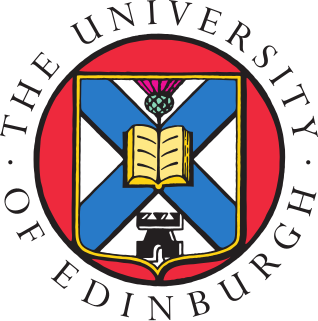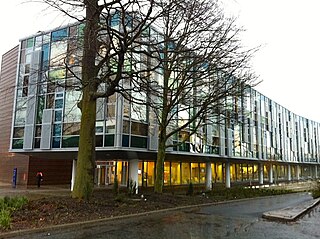Related Research Articles

The Medical Research Council (MRC) is responsible for co-coordinating and funding medical research in the United Kingdom. It is part of United Kingdom Research and Innovation (UKRI), which came into operation 1 April 2018, and brings together the UK's seven research councils, Innovate UK and Research England. UK Research and Innovation is answerable to, although politically independent from, the Department for Business, Energy and Industrial Strategy.

Heriot-Watt University is a public research university based in Edinburgh, Scotland. It was established in 1821 as the School of Arts of Edinburgh, the world's first mechanics' institute, and subsequently granted university status by royal charter in 1966. It is the eighth-oldest higher education institute in the UK. The name Heriot-Watt was taken from Scottish inventor James Watt and Scottish philanthropist and goldsmith George Heriot.
Edinburgh Napier University is a public university in Edinburgh, Scotland. Napier Technical College, the predecessor of the university, was founded in 1964, taking its name from 16th-century Scottish mathematician and philosopher John Napier. The technical college was inaugurated as a university in 1992 by Lord Douglas-Hamilton, becoming Napier University. In 2009, the university was renamed Edinburgh Napier University.

The School of Informatics is an academic unit of the University of Edinburgh, in Scotland, responsible for research, teaching, outreach and commercialisation in informatics. It was created in 1998 from the former Department of Artificial Intelligence, the Centre for Cognitive Science and the Department of Computer Science, along with the Artificial Intelligence Applications Institute (AIAI) and the Human Communication Research Centre.
Biotechnology and Biological Sciences Research Council (BBSRC), part of UK Research and Innovation, is a non-departmental public body (NDPB), and is the largest UK public funder of non-medical bioscience. It predominantly funds scientific research institutes and university research departments in the UK.

The Bartlett Faculty of the Built Environment is the academic centre for the study of the built environment at University College London (UCL), part of the University of London in London, United Kingdom. It is home to twelve departments that have expertise in individual fields of the built-environment, including the Bartlett School of Architecture, Bartlett School of Planning, Bartlett Development Planning Unit, and Centre for Advanced Spatial Analysis. The Bartlett is consistently ranked the highest in Europe and the UK and among the highest in the world for the "Architecture and the Built-Environment" category in all major rankings. In the 2019 QS World University Rankings, it was ranked first in the world, and is currently ranked 2nd in the 2021 Rankings.

Queen Margaret University is a university, founded in 1875 and located in Edinburgh, Scotland. It is named after Saint Margaret, wife of King Malcolm III of Scotland. Its predecessor, Queen Margaret University College, was awarded full university status becoming Queen Margaret University in January 2007.

The King's Buildings is a campus of the University of Edinburgh in Scotland. Located in the suburb of Blackford, the site contains most of the schools within the College of Science and Engineering, excepting only the School of Informatics and part of the School of Geosciences, which are located at the central George Square campus. The campus lies south of West Mains Road, west of Mayfield Road and east of Blackford Hill, about 2 miles (3.2 km) south of George Square. Scotland's Rural College (SRUC) and Biomathematics and Statistics Scotland (BioSS) also have facilities there.
The University of Edinburgh Medical School is the medical school of the University of Edinburgh in Scotland and the United Kingdom and part of the College of Medicine and Veterinary Medicine, the head of which is Moira Whyte, who has also been head of the school since 2016. It was established in 1726, during the Scottish Enlightenment, making it the oldest medical school in the United Kingdom and is one of the oldest medical schools in the English-speaking world.
The Medical Research Council (UK) Human Genetics Unit is situated at the Western General Hospital in Edinburgh. It is one of the largest MRC research establishments, housing over two hundred scientists, support staff, research fellows, PhD students, and visiting workers.

The University of Edinburgh is a public research university in Edinburgh, Scotland. Granted a royal charter by King James VI in 1582 and officially opened in 1583, it is one of Scotland's four ancient universities and the sixth-oldest university in continuous operation in the English-speaking world. The university played an important role in Edinburgh becoming a chief intellectual centre during the Scottish Enlightenment and contributed to the city being nicknamed the "Athens of the North".
Austin Gerard Smith is a professor at the University of Exeter and director of its Living Systems Institute. He is notable for his pioneering work on the biology of embryonic stem cells.
The College of Science and Engineering is one of the three colleges of the University of Edinburgh. With over 2,000 staff and around 9,000 students, it is one of the largest science and engineering groupings in the UK. The College is largely located at the King's Buildings campus and consists of the separate schools of:

The University of Edinburgh School of Physics and Astronomy is the physics department of the University of Edinburgh. The School was formed in 1993 by a merger of the Department of Physics and the Department of Astronomy, both at the University of Edinburgh. The Department of Physics itself was a merger between the Department of Natural Philosophy and the Department of Mathematical Physics in the late 1960s. The School is part of the University's College of Science and Engineering.

The Edinburgh BioQuarter is a bioscience community based in the Little France area of Edinburgh. It is a key initiative in the development of Scotland's life sciences industry, which as of August 2020 employs more than 39,000 people in over 750 organisations. An estimated 8,000 people work or study at the BioQuarter, generating £280 million in gross value added each year. The BioQuarter site is not expected to be fully occupied until around 2036, but is already the third largest bioscience community in the UK, after Cambridge and the Newcastle Helix at Newcastle University.

The Centre for Regenerative Medicine (CRM) is a stem cell research centre at the University of Edinburgh in Scotland, dedicated to the study and development of new regenerative treatments for human diseases. The centre forms part of the University's Institute for Regeneration and Repair and is part of the BioQuarter cluster at Little France.
The Institute for the Study of Science, Technology and Innovation (ISSTI) is an interdisciplinary research centre based in the UK. The research network was established in 2001 to bring together groups of academics and individual researchers across the University of Edinburgh, Edinburgh, UK. It consolidates activities in research, teaching and knowledge transfer on social and policy aspects of science, technology and innovation.

The Roslin Institute is an animal sciences research institute based at Easter Bush in Midlothian, Scotland. Since 2008, it has been part of the University of Edinburgh's Royal (Dick) School of Veterinary Studies, and is one of eight intitutes that receive strategic funding from the Biotechnology and Biological Sciences Research Council.

The Edinburgh Cancer Research Centre (ECRC), also known as the Cancer Research UK Edinburgh Centre and the University of Edinburgh Cancer Research Centre, is a center for basic, translational and clinical cancer research located in Edinburgh, Scotland. ECRC constitutes a part of the Institute of Genetics & Molecular Medicine (IGMM) and is positioned in direct proximity of the Western General Hospital, where most of its clinical activities take place.
Arcot Ramachandran (1923-2018) was an Indian scientist, anthropologist, author and a former Under-Secretary General of United Nations Centre for Human Settlements, known for his scholarship on the subjects of heat and mass transfer and environment and his social commitment to the cause of sustainable development. The Government of India honoured him in 2003, with the Padma Bhushan, the third highest civilian award, for his services to the fields of Science and Engineering.